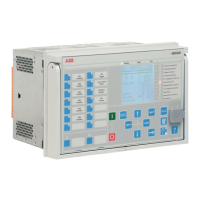or time requirement is again fulfilled. Another possibility is that if the time
condition is not fulfilled for an instantaneous dip detection but the signal rises
above
Voltage dip set 1
, the already elapsed time is included in the momentary
dip timer. Especially the interruption time is included in the dip time. If the signal
does not exceed
Voltage dip set 2
before the timer
VVa dip time 2
has elapsed
when the momentary dip timer is also started after the magnitude undershooting
Voltage dip set 2
, the momentary dip event instead is detected. Consequently, the
same dip occurrence with a changing variation depth can result in several dip event
indications but only one detection. For example, if the magnitude has undershot
Voltage dip set 1
but remained above
Voltage Intr set
for a shorter time than the
value of
VVa dip time 1
but the signal rises between
Voltage dip set 1
and
Voltage
dip set 2
so that the total duration of the dip activation is longer than
VVa dip
time 2
and the maximum time is not overshot, this is detected as a momentary dip
even though a short instantaneous dip period has been included. In text, the terms
"deeper" and "higher" are used for referring to dip or interruption.
Although examples are given for dip events, the same rules can be applied to the
swell and interruption functionality too. For swell indication, "deeper" means that
the signal rises even more and "higher" means that the signal magnitude becomes
lower respectively.
The adjustable voltage thresholds adhere to the relationships:
VVa dip time 1
≤
VVa dip time 2
≤
VVa dip time 3
.
VVa swell time 1
≤
VVa swell time 2
≤
VVa swell time 3
.
VVa Int time 1
≤
VVa Int time 2
≤
VVa Int time 3
.
There is a validation functionality built-in function that checks the relationship
adherence so that if
VVa x time 1
is set higher than
VVa x time 2
or
VVa x time
3
,
VVa x time 2
and
VVa x time 3
are set equal to the new
VVa x time 1
. If
VVa x time
2
is set higher than
VVa x time 3
,
VVa x time 3
is set to the new
VVa x time 2
. If
VVa
x time 2
is set lower than
VVa x time 1
, the entered
VVa x time 2
is rejected. If
VVa x
time 3
is set lower than
VVa x time 2
, the entered
VVa x time 3
is rejected.
10.3.4.4 Duration measurement
The duration of each voltage phase corresponds to the period during which
the measured TRMS values remain above (swell) or below (dip, interruption) the
corresponding limit.
Besides the three limit settings for the variation types dip and swell, there is also
a specific duration setting for each limit setting. For interruption, there is only
one limit setting common for the three duration settings. The maximum duration
setting is common for all variation types.
The duration measurement module measures the voltage variation duration of each
phase voltage separately when the
Phase mode
setting is "Single Phase". The phase
variation durations are independent. However, when the
Phase mode
setting is
"Three Phase", voltage variation may start only when all the monitored phases
are active. An example of variation duration when
Phase mode
is "Single Phase"
can be seen in
Figure 580
. The voltage variation in the example is detected as
an interruption for the phase B and a dip for the phase A, and also the variation
durations are interpreted as independent U_B and U_A durations. In case of single-
phase interruption, the DIPST output is active when either ST_A or ST_B is active.
The measured variation durations are the times measured between the activation
of the ST_A or ST_B outputs and deactivation of the ST_A or ST_B outputs. When
1MRS757644 H
Power quality measurement functions
620 series
Technical Manual
1095

